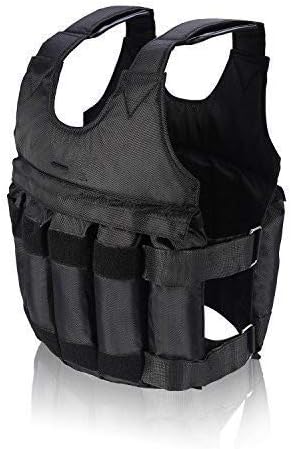By Nancy Alexander, PT, CSCS
As you get older you might be wondering how you can help prevent bone loss. If you already have decreased bone density such as osteoporosis or osteopenia, you know that an exercise program which helps reduce bone loss is critical for your health. Three known strategies to strengthen your bones include weight-bearing movement or exercise, impact, and resistance training.
But what about weighted vests? Is that something you should consider? Weighted vests have been discussed in the literature to determine if they are a viable option for those looking for another way to build stronger bones. Please read further for more information as we explore this option.

Source: Amazon.com
Weighted vests are an upper body garment with pockets that can hold removable weights. They can be put on over your head or donned and doffed like a coat. They hang from your shoulders and often have a wide strap around your waist to help keep the vest in place. You can adjust the amount of weight you are wearing by what you put in your pockets. In theory, the more weight you are carrying, the more this would help to strengthen your bones. Great news you might think. But please take a closer look.
Some people do benefit from them. Wearing a weighted vest for strength training purposes is well documented with a younger population and for those training for very physical pursuits including military personnel and our first responders. When it comes to building bone strength in adults over 65, however, the evidence is scant.
“No studies have shown that fracture risk is decreased when wearing weighted vests,” according to American Bone Health (March 20, 2019), “It has not been proven in any studies. The data does seem to support, however, an advantage of wearing a weighted vest IF you use it together with fairly aggressive muscle training exercise.” Trouble is, it is hard to discern the source of the benefit here. Resistance training alone has been proven to reduce bone loss.
Another study, according to American Bone Health, offered some hope of long-term bone density stability with the use of a weighted vest. During a 5-year study of nine women, participants chose to perform a supervised exercise program while wearing a weighted vest. These women jumped up and down an average of four inches, 52 times, three times per week for five years. Compared to the women who did not exercise, the bone density in their hips was relatively stable, while the 5-year cumulative loss was 3-4% in those who did not participate.
Some benefits of wearing weighted vests, aside from bone health, have been established. They include increased leg strength and improved balance, both of which are valuable as they could improve your safety and mobility.
Wearing a weighted vest may work, or it may not work, when it comes to building stronger bones. Any discussion though requires identifying the risks associated with wearing this type of vest. Always talk with your doctor before beginning any new exercise program including the use of weighted vests, especially if you have an existing condition that could be aggravated by excess weight and/or an increased compression on your body in a downward fashion. This could include arthritis at your spine, hips, knees, or ankles. Also included would be a history of a back injury or fracture with or without a resulting surgery. And because the vest is hanging from your shoulders, you risk aggravating shoulder, arm, neck, and back pain because of this downward pull. Because of the added weight you are carrying, there is also potential for increased load on your cardiovascular and respiratory systems.
If you are interested in trying one and your physician agrees, sources listed below offer some guidelines to consider when wearing one:
- Be sure the vest fits well and is secured to your body. A vest that shifts can alter your balance and lead to a fall risk.
- Weighted vests should not exceed 10% of your body weight. For example, added weight should not exceed 15 pounds if you weigh 150 pounds.
- Add weight gradually to protect your joints from too much load too fast. Some research suggests starting with one or two pounds and then increasing it from there. Your physician should be able to guide you.
- Watch for increased joint pain and stop use if this occurs. If this is not easily relieved, discontinue use and visit with your doctor right away.
There is a conundrum here. When you look at weight-bearing activities you often think of walking, exercise classes with impact through your feet (and even your arms) and running. Some of these, however, can increase joint pain at your weight-bearing joints including your knees, hips, and spine because of the added impact. A weighted vest can easily exacerbate this. What is potentially good for one condition can be bad for the other. As we age, our chance for joint pain increases as well. This is why a consult with your health professional is so important. They know your health history intimately and can guide you to help you choose types of physical activity that are safe for you and good for your bone health.
When it comes to bone health, three strategies have been proven successful:
- Perform weight-bearing exercise such as walking.
- The amount of force you land with is called impact. Maximize your impact in keeping with joint tolerance.
- Perform resistance training which helps build stronger bones, especially where the muscles/tendons attach to the bone.
Consider participating in an exercise program that incorporates these strategies into their design. Listen to your body. Stop if you experience joint pain or any pain that is not easily relieved. Consult with your health care professional for guidance.
Be informed. Be well.
Sources:
https://www.niams.nih.gov/health-topics/exercise-your-bone-health

Leave a Reply